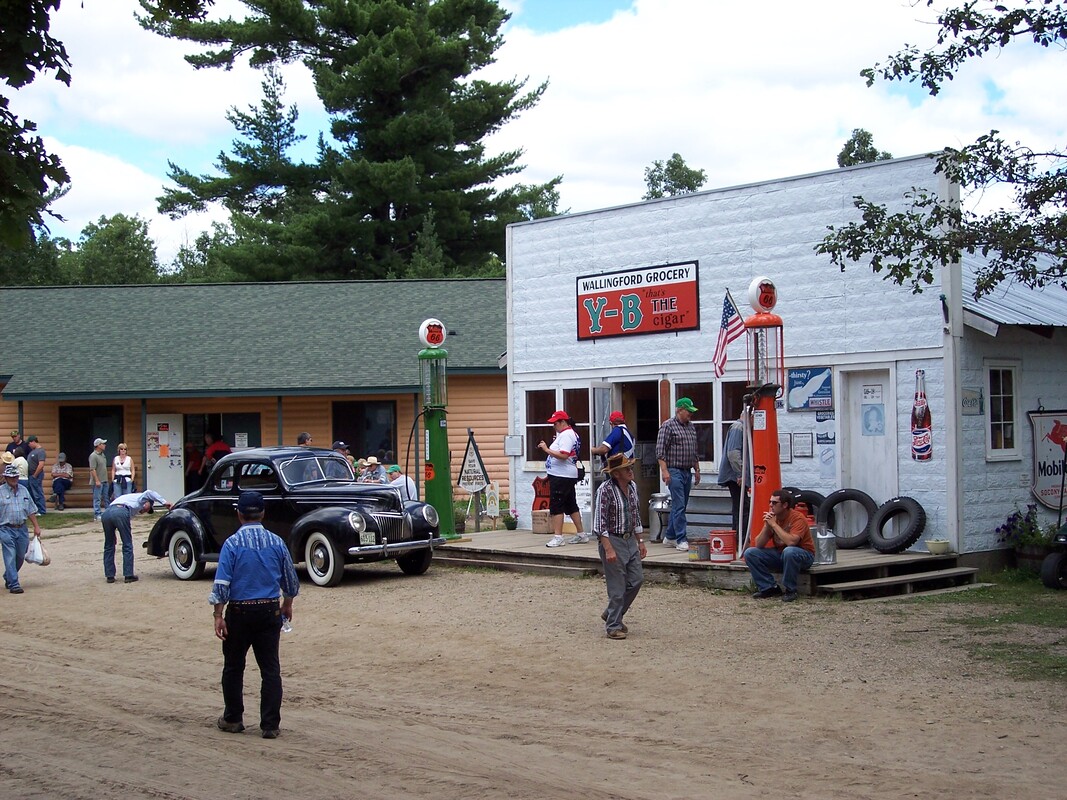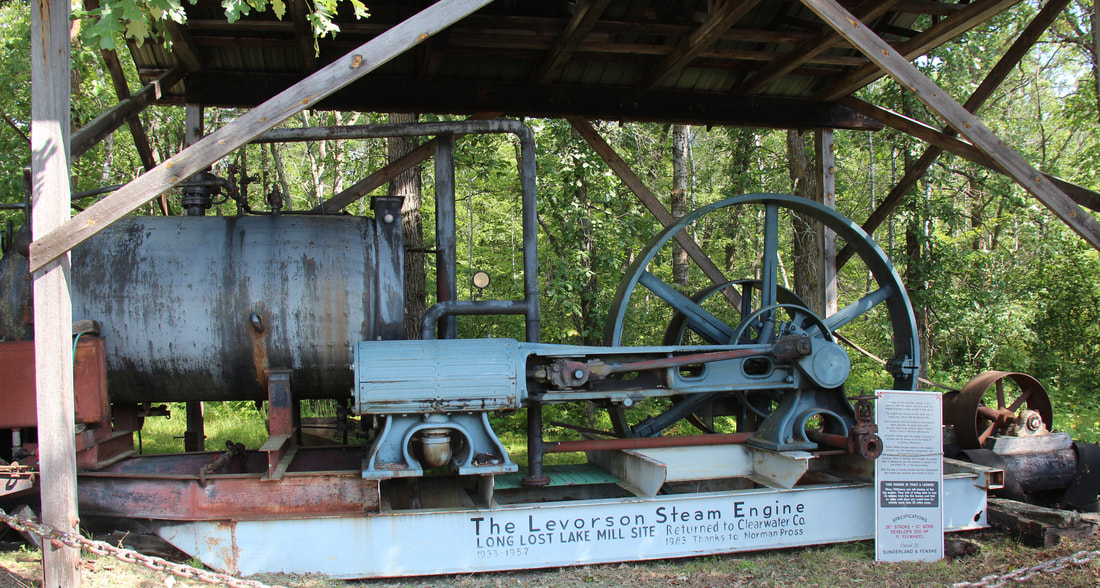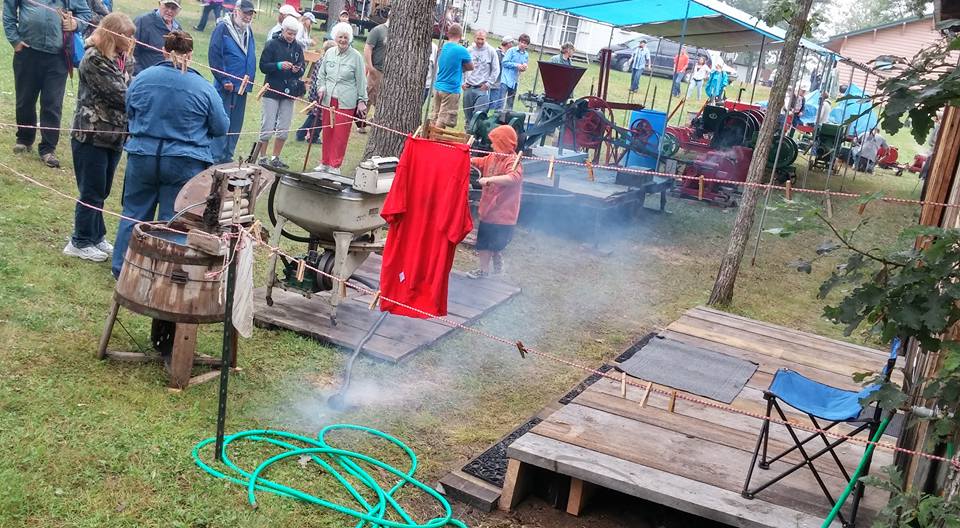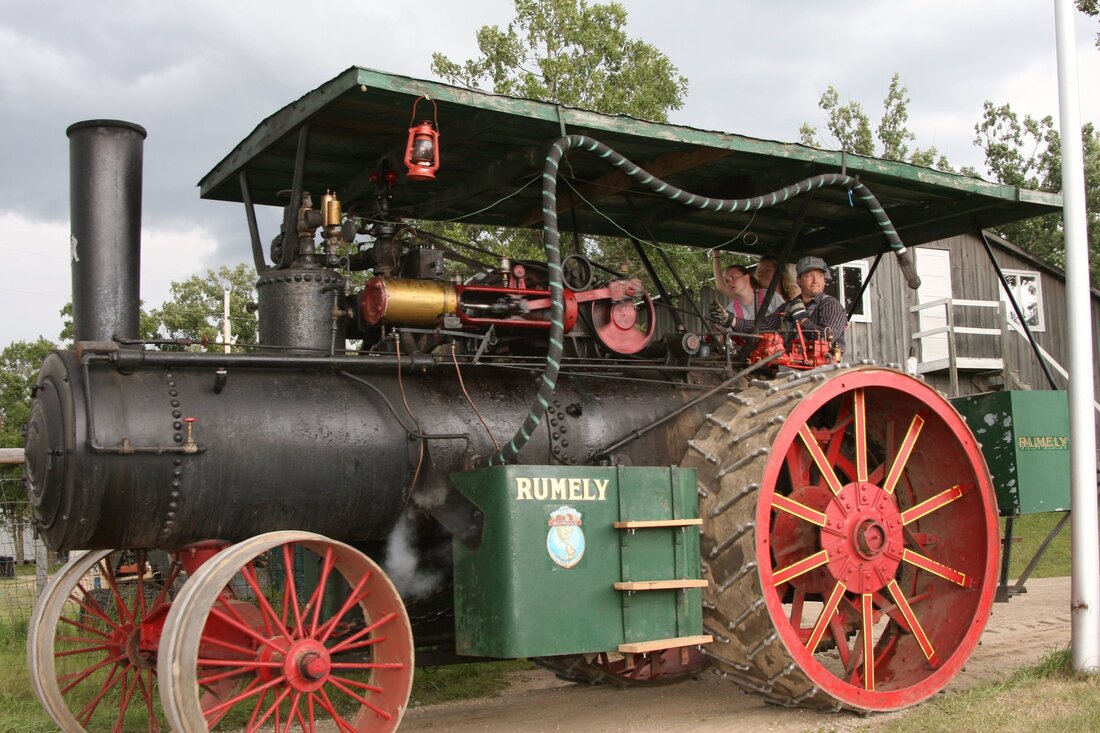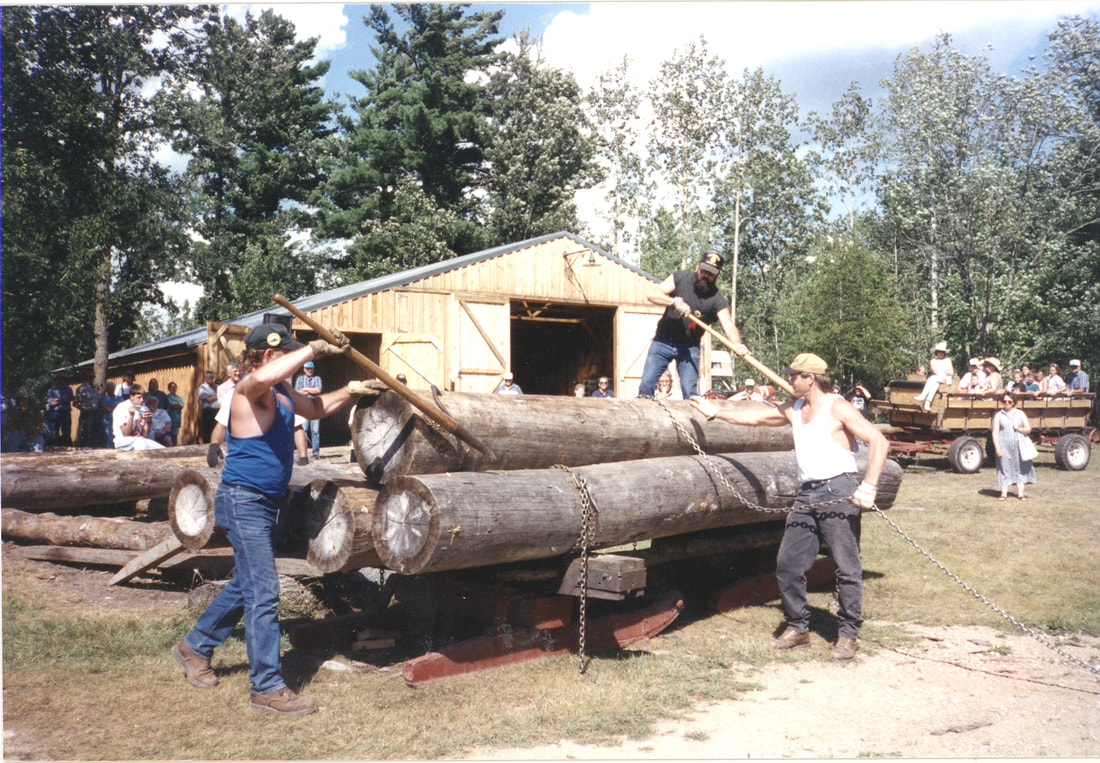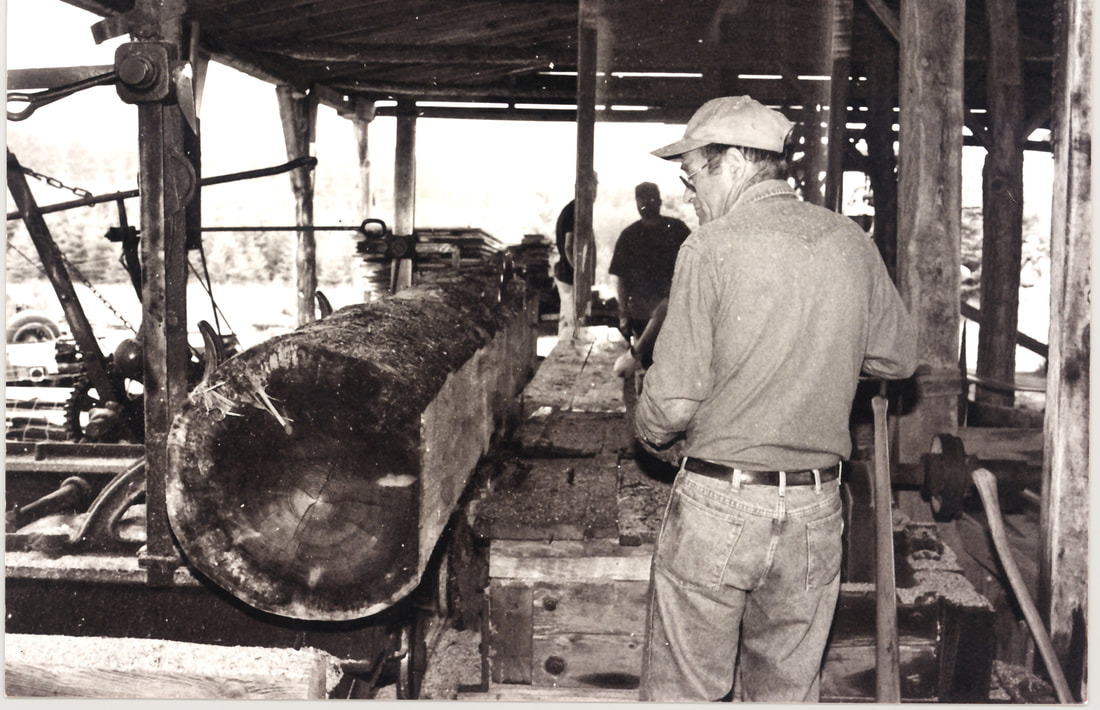History Of Lake Itasca Region Pioneer Farmers
|
"This story finds it onset back in 1976;
For that was one-eventful time, in memory to affix. The US Bi-Centennial was coming on that year; And plans were being made to celebrate it, far and near! Now Bagley, Minnesota, was not to be outdone; For they would plan a big parade, and also lots of fun. In August, this would happen, once the county fair was o'er; And it would be a great event, to last three days or more! Some local men were called and asked about a threshing show; The crux was-could they put one on? They said they reckoned so. A few of them, experience had, to do this sort of thing; And other were quite ready to help plan this happening! Many meetings then took place in June and in July; With little in the way of funds, yet they were set to try; To make a very special day to help relive the past; Of agricultural pageantry - the time was coming fast! Words of invitation were soon passed all around; To gather up old tractors, where'er they might be found. And old gas engines and farm machinery; To represent the years gone by in rural history! A few scoffed at the idea, and said it wouldn't work; But that did not deter the men, for none were seen to shirk. As together, they all labored, everyone to do his part; To help to make the threshing show a country work of art! The summer passed by - oh, so fast, and soon approached the day; The threshing show would happen a parade would lead the way. Up to the county fairground, where everything was set; Tractors, threshers, engines, every need had now been met! Now this took place on Saturday, and later on, that night; An old- time fiddlers contest, an audience would delight. Then on Sunday morning, a big breakfast was held; Of pancakes, eggs, and sausage, how good that food all smelled! The day eventfully was filed, with activites galore; With threshing, lumber sawing, gas engines, and much more. A good parade of tractors and machines passed in array; And then and old time tractor pull did finish off the day! Tired but quite satisfied, were workers at day's end; And many compliments were heard, such as: "Will you do it again?" One-thousand visitors had some to see and share the fun; The threshing show was history - a new era had begun! |
Encouraged by the good success, the workers did decide,
To organize and charter a club which would provide; This kind of entertainment in the years which were to come; Officers, they did elect, and things began to hum! LAKE ITASCA REGION PIONEER FARMERS was the name they chose; And at that time, I don't believe that anyone would suppose; That in the future this small group would ever gain renown; As their yearly shows continued at the outskirts of the town! The ladies too, did organize the "RIIPLES" they were called; How those girls made money! In their efforts, never stalled. As they prepared and served the meals, lunches, coffee too;; In all ways dedicated, and an oh so faithful crew! The show was held at Bagley for exactly fourteen years; And then, as if from out the blue, opportunity appears. To purchase ground and re-locate down by Itasca Park; And the dream of owning showgrounds did ignite a brand new spark! Nineteen-ninety found the Pioneers established on their ground; And as their fist show did take place, quite pleasantly they found. That crowds were even larger than any seen before; And to further then enhance the show, they added one day MORE! Each year, an added building, and sometimes two or three! Have amplified our efforts to program history. An ample auditorium, six-hundred folks will sear; For Sunday worship services, music shows, and a place to eat! The good food from the kictchen, all prepared by volunteers; Who help make up the backbone of the Itasc Pioneers. The grounds offer museums, a church and schoolhouse, too; A log house and a blacksmith shop; these are but a few! Of the many special buildings, each one in its own way; Adding to the programs of the Pioneers Today. When thee shows are taking place, kind compliments are heard; Surely is appreciated, each thoughtful spoken word! The Pioneer show buttons do honor every year; Faithful members, one of more, whose efforts hold them dear. And a Pioneer King and Queen are chosen from our ranks; To reign o'er the activities, a way to show our thanks! First rate music is performed, in days and into night; The little railroads runs all day, to young and old's delight! On Saturdays, a style show is something the behold; And many come to sit and watch its pageantry unfold! |
The programming on Sawmill Hill gives onlookers a chance;
To look back into yesterday, and memory, enhance! If while there, you're thirsty or you want a little treat; A building there has pop and chips and other snacks to eat! Two museums of logging hold a wealth of history; Of logging days away back when it was done differently. A third one is a grocery store from many years ago; Its shelves stocked with consumed good and depression prices, low! Gas engines of all sizes bark and pop throughout the show; And hot-air engines whisper - so silently, they go. Tractors of all sizes, makes, and colors may be found; Majestically parading, or just lined up on the ground! A great number of crafters are on hand to do their 'thing!" While over in the blacksmith shop, the hammers sharply ring! The Reid's engines' big flywheels slowly turn as if to say: "We once pumped oil from down below, back in our heyday!" Eating places on the grounds which surely must be tried; include the lefse kitchen and the corn grill just outisde. The snack shack also offers ice cream sundaes, shakes, and more; And for coffee, ice-cold pop and goodies, there's the country grocery store! In the one room schoolhouse, former teachers stand and tell; How education used to be and in many ways, worked well. The Pioneering log house has a charm that's all its own; As visitors get a glimpse of what was once a country home! The old Buceye steam engine owned by Albert Levorsen; Stands stately in its building, a relic from back when. While over in another spot, the Murray-Corliss purrs; The steam exhauset is hissing, the giant flywheel whirs! The Fairbanks upright diesels, so quietly do throb; In making electricty, they once did a mighty job. Water-pumping engines, all lined up in a row; Work their jacks and do produce a steady water flow! The big Prim diesel engine is a so attractive sight; Sometimes, when getting started, it sounds off like dynamite! But when it levels off, it hums, smoothly and so slow; A tribute to its owners who have made it run just so! Don't forget the tractor pull on Sunday afternoon; Where entrants wait so eagerly, with engines all in tune. To vie for plaques and trophies; some win---and some have to lose; But it's good competition, and one which many choose! Many things have taken place since twenty years ago, now past; Sometimes it's hard to realize how we could grow so fast! From just one little building back then in 'seventy-nine; We've grown to more than thirty now, of rustic style so fine! I am going to tell you something, of which I'm confident; God's been with the Pioneer Farmers, every step they went. He's blessed them with good leadership, good directors, too; In situations trying, He has always seen them through! As you continue, Pioneers, along your special way; I feel so humbly thankful, a small part I could play. In helping to pursue the dream that's ever coming true; And for each day that lies ahead; I say: "May God Bless You!" -Bob A.Bilden Co-founder and First President of Lake Itasca Region Pioneer Farmers |
|
The Lake Itasca Region Pioneer Farmers (LIRPF) organization was incorporated under Minnesota Statutes and received its articles of incorporation and its seal in 1976, the year of the U.S. Bi-Centennial and became a 501C3 non-profit, tax-exempt entity in 1993. No salaries or compensation of any kind are paid to any LIRPF members. All profits generated are used to improve the grounds, construct and maintain buildings, and to purchase and preserve historic, rural, logging, and other artifacts. It's further goal is to (where necessary) recondition and restore such items, and to display them for the historical, cultural, recreation, civic, and education benefit of the public, now, and for the future generations.
It was the early summer of 1976, and plans were being formulated across the U.S. to celebrate the country’s bi- centennial, in both elaborate and also in elementary ways. Bagley, Minn. was certainly intending to stage events, too. Likely in early June, an invitation was extended to Norman Chase and Bob Bilden to put together a threshing demonstration as a part of the Bagley observance which would take place in late August. The two men met with the Bagley U.S. Bicentennial Committee to further discuss the matter, and one well remembered comment heard at that meeting was, “An old-time threshing show? I just can’t see it!!” (Very encouraging, to say the least!) As time passed, several planning meetings were held in Bagley, and others who attended besides Chase and Bilden included A.L. Johnson, Bill Martine, Ole Ysen, Oliver Eastwood, Grant Fischer, Jennings Sunderland, Pastor Milan Davig, Tom Haney, and others. The search for old tractors, engines and machinery then began. It was decided that the threshing show part of the celebration would begin with a fiddler’s contest on Saturday evening at the fairgrounds, and Sunday’s events would include an old-fashioned thresherman’s breakfast, a down- town parade of tractors and machinery to the fairgrounds, and the balance of the day devoted to activity there, which would include: lumber sawing, another parade, threshing (two rigs), gas engine exhibits, and finally, an old-time tractor pull for plaques. At day’s end, a tired, however inspired group noted that more than 1,000 people had come to enjoy the day’s events, and, a lot of favorable comments were heard to add encouragement to the efforts. NOW things were ready to begin happening! -- and the timeline was to begin as follows: Fall-Winter 1976: A banquet was held at the Viking House in Bagley for those who had gotten involved in the show, and organizational efforts were begun. A steering committee of seven men was chosen to head up the me- chanics of it. Articles of Incorporation were soon drawn up, and the name “Lake Itasca Region Pioneer Farmers, Inc,” chosen. The ladies organized to become “the Lake Itasca Ripples.” The Bagley Bi-Centennial committee gave left over money ($450) to the new organization, and the seven members of the steering committee became the first officers and directors. All members who had joined, plus all who joined yet that year were considered to be charter members. 1977: A two-day event was held with basically the same activities, except that a Sunday worship service is added, and the first LIRPF poster and souvenir buttons are introduced. “Farmer Dan” Chase begins as show emcee and continues until 1985. The cut-off of charter memberships takes effect and further memberships begin with “101.” The first LIRPF teen queen (Kim Johnson) was crowned. 1978: Ole Ysen chosen to be the first LIRPF member to be honored on the show souvenir button, beginning a practice that has been continued to the present day. 1979: The first “show-owned” building is assembled on a two-wheeled trailer, and all business during the show is conducted from it. The first Country/Old time music show is held on Friday night with an appreciative audience of more than 450 in attendance. “Farmer Dan” emcees the event. 1980: The first Minnesota State Championship Old-time Tractor pull (title never challenged) is held for trophies and plaques. 1981-89: Nine more consecutive shows are held at the fairgrounds, with only one rain-out (1989) occurring during the 14 years the shows are held there. A few daytime events are held on Fridays as well as Saturday and Sunday. Attendance at Sunday worship services averaged from 35 to 50. The A.J. Levorsen sawmill engine is restored and running in 1984. The fairgrounds era comes to an end. 1990: First three-day show, with Friday being added due to the request from a number of visitors who came on that morning and asked for a parade. First Gospel music show held on Friday night. Golden Street Quartet headlines. Country/Old-time music show moves to Saturday night. John and Wanda Fittje are crowned Pioneer King and Queen. Walter and Clara Busse are chosen as show button honorees. Wes Luggar organizes a volunteer choir to sing at Sunday Worship services. Missionary and LIRPF member George Knapp speaks at worship service. More than 250 attend worship service. Visitors comment very favorably on new show site and wish us success. New auditorium and kitchen are put into use. Anderson Brothers’ and Busses’ new buildings open for display. 1991: A large portion of the developed grounds are landscaped and seeded. Construction of the blacksmith shop begins. The Itasca centennial wagon train is welcomed and hosted at a luncheon upon their arrival from the Twin Cities in June. Displays and exhibits continue to grow. The original portable show building becomes the “Snack Shack.” Bill Wendlandt, Doug Halvorson, and Gerald Landmark are pictured on the show souvenir button. Edgar and Nellie Wibbels are crowned Pioneer King and Queen. They ride in Edgar’s little runabout during the parades. Pastor Clarence Watkins brings the message at Sunday Worship service. 1992: The Fairbanks-Morse three-cylinder diesel is operated for the first time. The new blacksmith shop is in use. The North Itasca Railroad is completed, Emmett Anderson operates his locomotive and cars on it. Ken and Delores Felt are selected as Pioneer King and Queen. Norris and Lila Strandlien are honored on show button. Pastor Larry Dorman speaks at worship service. Show attendance continues to increase, as does that of the music shows and the worship service. 1993: Ole and Wally Berge host the first Hot-Air Engine Collectors Invitational; these reunions have been the largest of their kind, and continue to the present. The Berges also erect the Berge Hot-Air Building. A 65-horsepower Case steam engine comes to the grounds on loan and is made operational on the first day of the show. It comes as a courtesy of the family of the late Reverend Henry Backer. Acreage is added to the grounds. Emmett, Ernest and Percy Anderson are pictured on show button. Pastor Bruce Hanks, well-known portrayer of Abraham Lincoln, brings message at worship service. Two buildings are moved in and remodeled for gas engine display, one for Stenseng Brothers and the other for Arnie Teige and sons. Emmett Anderson and Corinne Dagestad are chosen Pioneer King and Queen. A weight transfer skid for the tractor pulls is constructed. A bathroom and shower building is constructed. 1994: The Berge building is enlarged and more exhibitors come. The second railroad oval is built. A second well is drilled and a water system installed to it. A new ladies’ activity building is erected; Fran Skadsem becomes director. A second Fairbanks-Morse engine, a five-cylinder, is in place and in operation. A new building is erected over it and the three-cylinder one. Bob A. and Marlys Bilden are chosen Pioneer King and Queen. Pastor Spencer Bower is speaker at the worship service. Gerald Fenske, Jennings and Kurt Sunderland are pictured on show button. 1995: Hemmerich brothers Earl and Lenny put up new display building near sawmill and begin displaying items. Earl Hemmerich begins log-handling pageantry. A reviewing stand for parades and tractor pull is built. The LIRPF 20th annual show is observed. Norman and Anita Chase are honored on show button. The kitchen is added onto, adding greater preparation and serving area. Orville and Fran Skadsem are named Pioneer King and Queen. Pastor Ken Downey brings the worship service message. 1996: Don and Hazel Carter are chosen Pioneer King and Queen. An addition is built onto the blacksmith shop. LIRPF 20th anniversary (1976-1996) is noted. Orville and Fran Skadsem are pictured on show button. Pastor Rick Moore speaks at worship service. 1997: The Murray-Corliss engine and the bandsaw mill (J. Neils and company) are purchased and moved to the grounds. The Roy Hemmerich Memorial Building is added to. The Reid Engine Building is erected by Stensengs, Bolducs and Johannessohns. Ernest Anderson and Mae Johannessohn are chosen as Pioneer King and Queen. Pastor Lyle Twite brings the message at the worship service. Andy and Margaret Adamson are picked to be Pioneer King and Queen. Gary and Joyce Johannessohn are chosen as show button honorees. Pastor Paul Magelssen is guest pastor at worship service. 1998: Albert J. Levorsen Logging Memorial Building is erected. Olaf and Wally Berge are pictured on the show button. The Wallingford Grocery museum is built. A third well is drilled and a water system installed. Septic tank drain fields are installed. Alvin and Dorothy Katzenmeyer are selected to be Pioneer King and Queen. Pastor Tom Bower is guest pastor at worship service. 1999: The new Snack Shack is built. Lenny and Addie Hemmerich are pictured on show button. The Skadsem display building is built. Lowell and Alice Kastner are chosen to be Pioneer King and Queen. Pastor Harvey Swanberg speaks at the wor- ship service. 2000: The first four-color show poster is printed to mark the 25th annual show. The 2nd Hot-Air Engine Collectors International Expo brings builders and exhibitors from great distances, and more than 300 engines are shown; the new office building is built. Arvin Teige is pictured on the show souvenir button. 2001: Charlie Ellis is honored on show button at age 95. Gordon and Helen Johnson are crowned Pioneer King and Queen. Pastor Bob Cleveland speaks at worship service 2002: The Hines display building is constructed. A covered bridge is built and other construction is done on railroad. Ken and Donna Felt are chosen to be show button honorees. Norris and Lila Strandlien are picked to be Pioneer King and Queen. Pastor John Omans speaks at worship ser- vice. 2003: The railroad engine storage building is erected. A grounds-wide public address system is installed. The Skadsem Building is added to. Russ and Kathy Comer are pictured on the show button. Clarence and Marian Snelling are crowned Pioneer King and Queen. The Hubbard County District #21 schoolhouse restoration is completed. The Wastweet Kitchen is built and ready for use at show time. An annex to the Wastweet Kitchen provides space for Loren Nelson families to grill corn-on- the-cob. The Murray-Corliss engine is partially assembled on its pedestal. Pastor Verlyn Strenge brings the message at the worship service. 2004: A building is erected over the Murray-Corliss engine. Water and electrical hookups are installed for workers’ campground. Don and Dee Luggar are selected as show button honorees. Don and Joyce Trefz are chosen as Pioneer King and Queen. Pastor Ron Pulscher speaks at the worship service. Gartner display and storage building is erected. 2005: The Hemmerich museum is added to. Mayvin and Dee Teigland are picked as Pioneer King and Queen. The Reid engine building gets an addition. The 1902 Paulson log house is set on a foundation and renovated. The Arts and Crafts building gets interior make- over and a new sign. A kiosk is donated and becomes the tractor registration building. The LIRPF 30th annual show is observed. The Murray-Corliss building gets a concrete floor and is partially enclosed. Earl and Jeannine Hemmerich are featured on show button. Pastor Don Clausen brings message at the worship service. The Osage Baptist Church building is moved to the grounds and set on its foundation. Water and electrical installation is completed in workers’ campground. 2006: Thirty years have passed since first LIRPF show at fairgrounds at Bagley in 1976. Renovation of Osage church continues. Further renovation of Paulson log house continues. Loren and Deloris Nelson are chosen as show button honorees. Pastor Bill Ullom is guest pastor at worship ser- vices. The 16 years which have passed since the first show on the grounds in 1990 have certainly been eventful ones for the LIRPF members. New buildings have been added nearly every year and existing ones have been added to. At- tendances have increased also, and at a manageable rate. Much work has been done to enhance both the grounds and the programming of the August shows. A great measure of thanks is due the small but energetic and vision-minded cadre of members who have continued to “get the job done!” That vision, plus that of those who faithfully exhibit, entertain, and offer their services in so many other ways, has been the force by which the LIRPF has become the recognized and respected organization that it is today. (From the Memoreies-Fifth Edition book) |


